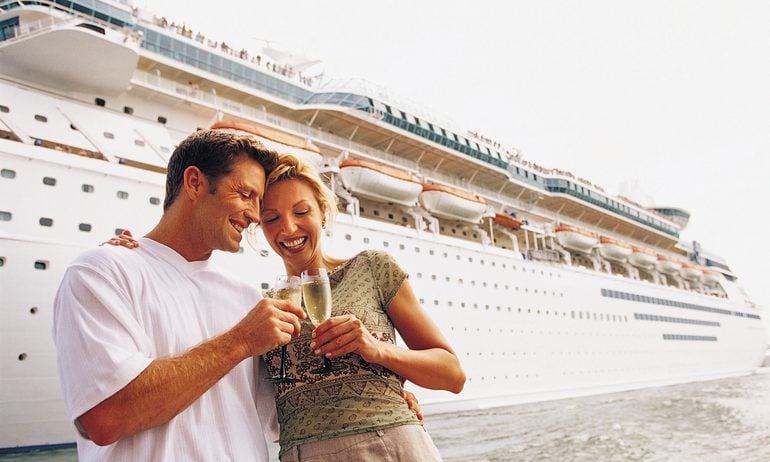The Pros and Cons of Cruises
Cruises are a convenient way to visit multiple destinations in one trip, but they can also be crowded and touristy.

Many or all of the products on this page are from partners who compensate us when you click to or take an action on their website, but this does not influence our evaluations or ratings. Our opinions are our own.
A cruise can satisfy the greatest wanderlust, satisfy your favorite (and newfound) food cravings and open new horizons and interests you never thought possible. But you can also fall for tourist traps or miss the authentic culture of the places you visit.
If you’ve never cruised, talk to others who have more firsthand insights. Their perspective can shed even more light on the experience you can expect.
Going on a cruise has pros and cons, and it may be worth reviewing them before your next sailing. Let’s look at the pros and cons of cruises.
Pros
A good deal
Cruises can be costly, but you get more than just a great view of the ocean. Cruise bookings often include your:
Accommodations.
Food.
Some drinks.
Entertainment.
Recreational amenities like pools and waterslides.
Other onboard activities.
You can step aboard the ship and not spend a penny if you play your cards right.
There are plenty of ways for cruises to pull more money out of your pocket on board (think: spa, specialty restaurants, upgraded drink packages, shore excursions, shops and casino), but you can still have plenty of fun without spending an additional dime.
Cruise lines are reinventing their onboard options, and specialty restaurants tap in to the talents of well-known chefs and restaurateurs. This can take some of the boredom away from the same dining rooms, but it comes at a cost.
For the most part, however, if you find a good price on the cabin, the number of inclusions that come with it can quickly drive down the cost of an overall vacation. Of course, the more you spend on the cabin (some of those luxury suites, for example), the lower the bargain you'll get.
» Learn more: Are cruises all-inclusive?
Entertainment and education galore
You read that right — you can learn something educational on a cruise.
Many cruises have port talks, destination immersion lectures covering the history and culture of a place, art galleries and trivia games. You can learn something on board, and then when you’re ashore, you can explore the destinations you visit.
Cruises are a great way to learn more about the world, meet new people and learn from them, too.
And there is more entertainment than you can shake a stick at on board and ashore. From musical performances to game shows and cinemas, you can easily fill up your schedule.
Every ship is different, so it is important to review what is available on your sailing if staying busy is your goal. Otherwise, bring a book and watch the world float by from the deck.
On sea days (when the ship is traveling between ports), it’s like having your own resort with pools and activities included in the overall cost of your vacation.
» Learn more: The best cruise lines
Top-tier dining experiences

The Royal Afternoon Tea with Royal Chef Darren McGrady on the Sun Princess. (Photo by Sally French)
Cruise lines are increasingly catering to both high-end tastes or just travelers seeking to try something new. New ships are launching unique, authentic experiences. Many are led by high-profile chefs. For example, British royal chef Darren McGrady, who once served Queen Elizabeth II and Princess Diana, helped create an afternoon tea experience for Princess Cruises.
And the trend even extends to more budget-oriented cruise lines. For example, Carnival Cruise Lines features Guy’s Burger Joint and Guy’s Pig & Anchor Bar-B-Que Smokehouse, both created by Food Network personality Guy Fieri.
Time efficiency
A cruise can introduce you to many places at once without your worrying about unpacking and repacking between destinations or paying for transportation between cities.
You unpack once and then are on your way, with all of the details handled for you — from immigration protocols to where to go and when.
The cost of a cruise includes a preplanned journey to some of the most popular points within a region and your transportation between them.
For example, your itinerary may have multiple Mediterranean cities or several European capitals.
There’s something quite relaxing about waking up each morning in a new city. And when you return after a day of exploring, housekeeping has cleaned your room.
A cruise may be a great option for less-frequent travelers because the cruise line is essentially “holding your hand” along the way.
Even better, some stops may be hard to reach by land — like many Alaskan ports — or expensive to reach independently, like some Greek islands or pricy ports in the Caribbean like St. Barts.
» Learn more: 6 cruises where you don't need a passport
Easier logistics for family and group travel
Cruises are an easy option for groups traveling together. Unlike on land, where it can be hard to find restaurant reservations for large groups or find one activity that suits every interest, cruises have something for everyone.
People can branch off to do what they like on the ship and then meet back up an hour later without worrying about traffic or safety issues for kids.
» Learn more: What's the best deck on a cruise ship?
Cons
Lots of people
While this varies by ship — some enormous ships have so much space that there are plenty of areas where you’ll be one of only a few people — crowds may flood popular areas.
For example, people vying for their moment in the sun may swarm the pool deck and families may descend on the water park area simultaneously.
Lines can form at popular buffets or restaurants at meal times, and when it’s time to go ashore (or disembark after the cruise), you’ll be one of many waiting in line.
Repetition
If you’re not willing to pay for specialty venues or you’re on a smaller ship that doesn’t have many free dining options, you may find that the dining rooms become repetitive. Menus change daily, but the setting does not. The window views at dinner will vary by destination, though, adding a bit of pizzazz.
If you make an effort, it is possible to find different things to do each day on almost all larger ships. River cruises, on the other hand, are much smaller and tend to feel more repetitive.
The same premise appears with the destinations for repeat cruisers. Because the cruise line plans itineraries, you may visit places you have been to multiple times if you sail often enough. It becomes harder to exclusively visit “new-to-you” places.
If it’s the latter you’re after, planning your own trip may be a better option.
» Learn more: Royal Caribbean vs. Carnival: Which is right for you?
One price is not always just one price
If you loosen your purse strings easily, spending more than you realize aboard a ship is possible.
A few cocktails by the pool each day, an extra tour or specialty restaurant dinner another, and before you know it, you’ve paid twice as much as you thought. It’s wise to board a ship with a budget in mind and plan your sailing accordingly so you don’t overspend without realizing it.
Those specialty cruise restaurants we mentioned earlier? They also tend to have a fee. And sometimes the price is close to what you'd pay on land — despite there being free food in the main restaurant anyway.
» Learn more: Best credit cards for cruises
Tourist traps
Cruise lines are often important economic engines for destinations. You may find yourself dealing with tourist traps, such as shops by the port, and beginner tours organized by the cruise line.
If you want the most authentic experience, it might be worth studying local guides and tour options online in advance to find something more authentic without falling for what’s waiting for you right at the port.
If you’re going on a shore excursion through the cruise line, you can count on being carted to places designed for large groups rather than hidden gems. Many tours often include a stop at a local shop or business that may be presented as authentic, but locals will tell you it is not.
This trend is amplified because travelers usually have only one day at each destination. As a result, time is of the essence to visit the most important sights without wasting it at tourist traps.
Frequent cruisers, however, will tell you that you should use a cruise to determine places you want to return to by using it as a sampler to explore many destinations. They also suggest planning what you want to do so you can hit the ground running.
Exploring independently or with a local guide (not booked through the ship) can often be your best bet. It also has the added benefit of directly supporting a local business or guide rather than funneling that cash through the cruise line.
The pros and cons of cruises, recapped
It’s unfair to decide how you feel about a cruise without trying one. Even those who insist they wouldn’t like one may end up having a good time.
Perception is not always reality, and you can be better prepared by considering all of the pros and cons of a cruise in advance. Talk with people on either side to get answers to your questions.
Not every type of travel is for everyone, but the ever-expanding cruise industry keeps adding amenities, perks and destinations. That alone speaks for itself.
How to maximize your rewards
You want a travel credit card that prioritizes what’s important to you. Here are some of the best travel credit cards of 2025:
Flexibility, point transfers and a large bonus: Chase Sapphire Preferred® Card
No annual fee: Wells Fargo Autograph® Card
Flat-rate travel rewards: Capital One Venture Rewards Credit Card
Bonus travel rewards and high-end perks: Chase Sapphire Reserve®
Luxury perks: The Platinum Card® from American Express
Business travelers: Ink Business Preferred® Credit Card
Capital One Venture X Rewards Credit Card
Travel
Hotel
With a big sign-up bonus, travel credits, high rewards and airport lounge access, this card could be well worth its annual fee — which is lower than many competitors.


